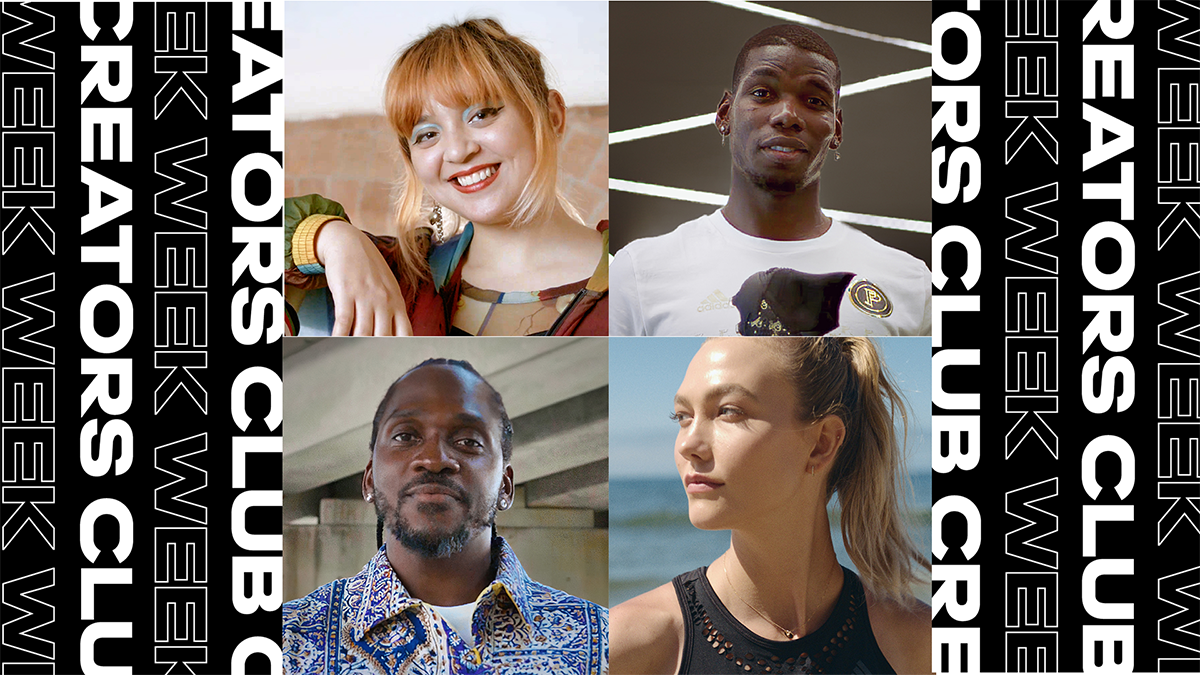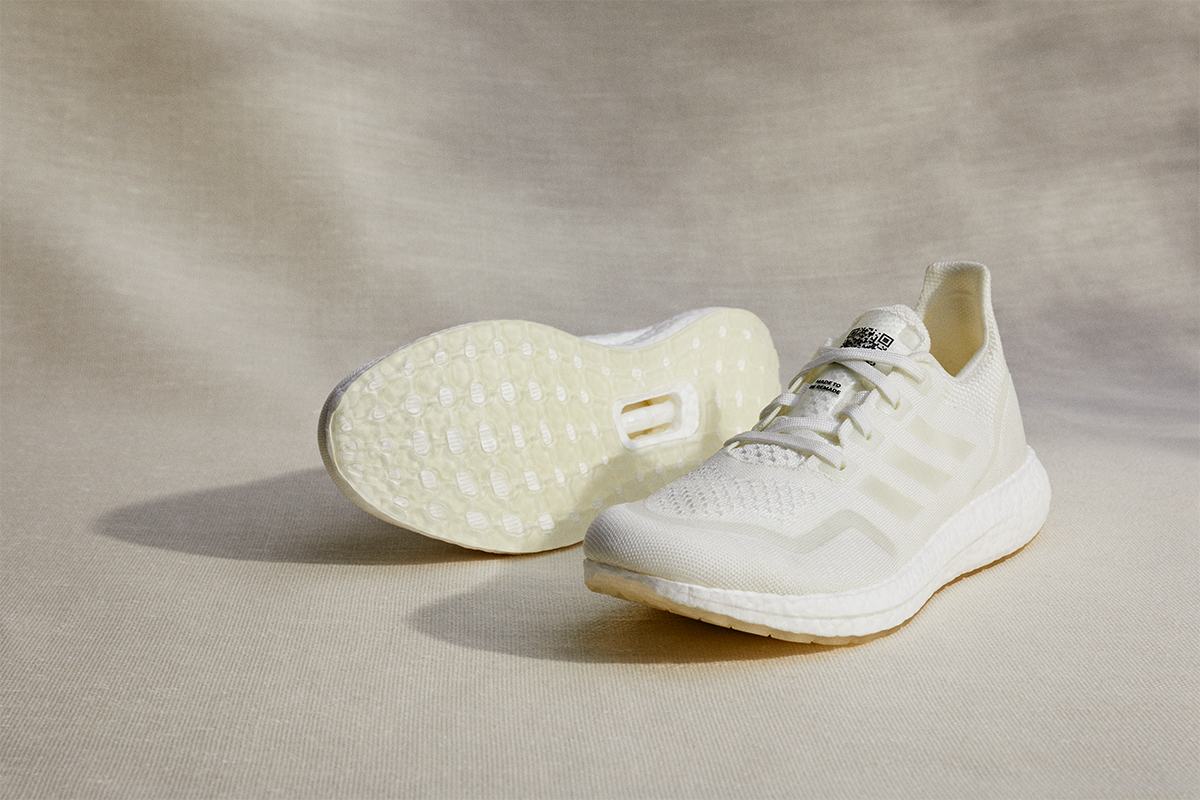
Adidas’ Creators Club Week, featuring Paul Pogba, Paulina Russo, Pusha T, and Karlie Kloss. Image courtesy of Adidas.
In response to rising protests against racial discrimination and social inequities and the COVID-19 pandemic, luxury fashion brands are contending with the importance of activist engagement along with continuing challenges around supply-chain management—touching issues related both to sustainability and the need for cultural and social changes in production. Linked too are the persistent questions that have long plagued the fashion industry. Are these products sustainable environmentally? How does the industry create more socially sustainable supply chains? Can a meticulously designed Prada handbag or a pair of premium, limited-edition Nike shoes stand for social justice while meeting consumers’ practical needs and desire for cutting-edge products?
Conversations around ethical advertising and the role of activists in fashion brand identities have gained increasing traction, but the phenomenon is not entirely new. The 1980s saw an increase in country-specific fair trade labeling focused, however, on coffee and agricultural products, as opposed to garment production. By the 2000s, eco-fashion changed from being a philanthropic niche to becoming a commercial reality, and the fashion industry has subsequently seen changes in design and creative direction toward being more sustainability-driven and corporate social responsibility (CSR)-focused. Growing attention to environmental and social sustainability issues has been gradual, at times even painfully slow. Major fashion brands have the influence to make positive social change and as a result have experienced increasing pressure to advance their sustainability agendas and to shift from a focus entirely on generating value for shareholders to also becoming purpose-led. Through the COVID-19 pandemic, publications from The Business of Fashion and McKinsey & Company have observed that sustainability topped the list of the biggest challenges facing the industry.
Recently a number of notable campaigns have addressed environmental impacts. Adidas began promoting four new Ultraboost running shoes designed to be returned at the end of their life cycle—while introducing their Creators Club Week to launch sustainable product designs and feature appearances from global icons talking about important topics such as ending plastic waste. As part of this marketing initiative, designer Paolina Russo remarked, “There’s so much deadstock. Rework those into [...] sustainable garments.” Additionally, the 2021 Adidas by Stella McCartney campaign ‘Futureplayground’, promoted activists in pieces made from sustainable materials —including farming activist Yuri Hibon and mental health activist Georgia Moot. Stella McCartney, frequently cited as an example of activism in fashion, also featured models with the environmental group Extinction Rebellion in their 2019 Agents of Change campaign, intended to promote the brand’s environmentally conscious clothes. Gucci introduced their first sustainable collection Gucci Off the Grid, created in line with their vision for circular production, and LVMH published their new environmental performance roadmap LIFE 360 to protect biodiversity, fight climate change, and foster circular economy practices.

Adidas Ultraboost, part of the Made To Be Remade product line. Image courtesy of Adidas.
Seeing sustainable fashion as increasingly urgent, luxury brand designers and artistic directors have also become more vocal. Donatella Versace, Miuccia Prada and Raf Simons acting as co-designers, and Louis Vuitton’s artistic director Virgil Abloh all recently published on their intent to tackle sustainability issues. Abloh described his vision for sustainable fashion design that can transcend seasonality. Prada and Simons’s photographer-less Spring/Summer 2021 debut was intended to engage online dialogue around issues like diversity, inclusivity, and sustainability. Thinking about COVID-19 and sustainability, Donatella Versace, in an interview with ELLE’s fashion features director Véronique Hyland said, “We started the sustainability discussion before COVID [...] In years and years, I had never seen Milan so clear [...] So sustainability is what I’m going to concentrate on most. I think we are going to be out of place, showing things that are not sustainable [...] step by step, we will get to a point when the environmental impact of fashion will be drastically reduced. So, this is my goal.” Hermès’ Executive Chairman Axel Dumas, publicly calling for social change, stated, “In 2020, we are seeing the affirmation of major strategic commitments with social and environmental responsibility, the digitalisation of uses and lifestyles, as well as positive market dynamics in Asia.”
Design for social impact has also been evident in recent ads and campaigns. Social sustainability in its close proximity to environmental sustainability, promotes social inclusion, making institutions accessible and accountable to citizens. This past year, for example, Nike released its anti-racist ‘Don’t Do It’ campaign in response to the death of George Floyd—which was produced and designed by Wieden+Kennedy Portland. Dior designed their first All Black Fashion show, and highlighted female artists such as feminist/artist Judy Chicago and contemporary artist Bharti Kher. Prada, seeking to deepen their commitment to diversity, equity, and inclusion, announced the Prada + Dorchester Industries Experimental Design Lab to recruit and recognize designers of color and UNFPA education initiative to foster gender equality in Africa. Also seeking to expand their educational initiatives, Fendi partnered with Juilliard to celebrate jazz and individuality, while also supporting the Juilliard College Scholarship Fund, and Gucci announced their scholarship fund Gucci Changemakers.

Image courtesy of the Immaculate Vegan.
The outcomes described are promising, yet a gap persists in terms of more explicit steps needed toward transparent, effectively designed sustainable supply chain practices. This led Extinction Rebellion to stage two weeks of protest where activists held signs with messages like ‘Won’t Wear Injustice’ and ‘Rather Be Naked’, acknowledging that unethical practices continue and that most luxury brands simply do not publish sufficient information about their environmental policies or provide any evidence of a commitment to ensuring that their workforce receives a living wage or safe working conditions. Looking to address this gap, Everlane began publishing photos of shop floors in its supplier factories in order to give a voice to factory workers, while Annick Ireland, CEO and Founder of Immaculate Vegan, has adamantly expressed that “sustainable design is a way of approaching design holistically, from using eco-friendly, plant-based materials, to employing sustainable manufacturing processes.”
With greater moves to embrace activism, even well-intentioned campaigns to promote ethical sourcing have been subject to public and media criticism. Premium vegan bag brand Matt & Nat was warned by the UK's Advertising Standards Authority (ASA) over exaggeration of its use of recycled materials. The ASA also challenged Louis Vuitton advertisements featuring a photograph of a woman stitching the handle of a handbag and another of a woman creating the folds of a wallet as misleading, as it could be interpreted that Louis Vuitton products were handmade during much of the production process. These misrepresentations have offered opportunities for companies to improve their ad concepts and designs, but also point to the fact that it wasn’t long ago that CSR grew into a central concern for luxury fashion companies and their consumers.
Traditionally, fashion supply chains have been replete with environmental and labor challenges. The industry consumes as much as one fourth of chemicals worldwide, releasing microfibers into water, and is responsible for around 2.1 billion tons of apparel thrown away annually. Luxury fashion items, much like premium and fast-fashion producers, are frequently manufactured unsustainably, and associated with worker exploitation. Factoring in existing unsustainable production, the fashion industry is responsible for approximately 4% of global greenhouse emissions due its energy-intensive practices that consumes more energy than the aviation and shipping industry combined. As the fashion market has expanded, the actions necessary to design, or redesign, environmentally and socially sustainable supply chains is a complex problem given fragmented global sourcing networks, downward price pressure, and lack of government regulation.
In terms of accessibility, the mass production of luxury goods has made these products more affordable, and the creation of accessible superpremium product categories has encouraged consumers to trade up to purchase iconic and luxurious products. ‘Trading up’ is a global phenomenon where consumers worldwide purchase higher-priced products instead of more affordable ones thanks to their outstanding brand identities and innovative qualities that stand out for functional and emotional differences. This type of purchasing behavior isn’t new per se, however ideological shifts took place when companies like Versace, Armani and Trussardi overtook their French cousins in terms of volume and turnover in the 1980s. Looking further back at this phenomenon, the post-World War II consumer after a decade’s psychic and material hardships [...] wanted cars, refrigerators, and household goods in unprecedented quantities. In light of historical precedents and with greater demand, massification makes luxury fashion now more readily available to middle-market consumers, and sustainability-focused ethical dilemmas are particularly pressing. A push for green supply chain design is intended to resolve environmental concerns, while also addressing social sustainability...associated primarily with labour conditions, well-being, quality of life, equality, diversity and connectedness.
In many cases, companies with ethical supply chain designs can outperform their competitors. Consumers however find it difficult to know which brands meet higher ethical standards than others. The luxury fashion market was once viewed as being more vertically integrated, however data from benchmarking studies, press coverage, and consumer activism has revealed that fashion companies may not understand their own worker recruitment process, who works in their supply chain, or how waste reduction works in obscure parts of the supply chain. Making sense of the data on sustainable practices in fashion can be frustrating, yet there have been some significant steps forward. Industry benchmarking in luxury fashion has expanded to include analyses from The Business of Fashion and McKinsey, Deloitte, The Fashion Revolution’s Fashion Transparency Index, The Know the Chains benchmarks, and The United Nations Global Compact. The Fashion Revolution, for example (represented by Fashion Revolution CIC and the Fashion Revolution Foundation) was created in response to the collapse of the Rana Plaza in Bangladesh where thousands of garment workers were injured or killed and it took weeks for brands to determine why their labels were found in the ruins and what sort of purchasing agreements they had with those suppliers. The Fashion Revolution was founded through charitable funding and has been able to develop their Fashion Transparency Index in order to incentivise and push major brands to be more transparent, and encourage them to disclose more information about their policies, practices and supply chain. One of their campaigns includes #whomademyclothes, a series of open-source posters that help to give garment workers a voice across social media platforms.
.JPG)
#whomademyclothes campaign post. Image courtesy of the Fashion Revolution.
With existing challenges and positive steps forward in mind, it can be viewed as an encouraging prospect that the COVID-19 crisis has seen consumers interested in the health and environmental impacts of their shopping choices. Through the COVID-19 global pandemic, luxury goods companies have contended with mounting pressure to navigate changes in public perception about the role of sustainability, ethics, and activism in the culture of fashion. Apparel and luxury sectors in fashion might consider the pandemic as a reset opportunity where brands can commit to sustainable practices and use the strength of their identities to fight social injustices. With a significant shift in purchasing behaviors during the pandemic, consumers have described that they now consider sustainability when making a luxury purchase. In these contexts, the role of the designer and creative director is especially important. Turin-based designer Andrea Poshar describes that “designers may intentionally or unintentionally work for or in conflict with the building of a new and better society.” Without question, these positive trends should continue beyond COVID-19, with design and communications becoming more policy-driven, sustainable, and supply-chain focused, and where luxury brands not only empower their own workers, but also continue to use their global influence to fight inequality and social injustices. As described by educator Toby Slade and cultural and fashion anthropologist M. Angela Jansen, “It is hard to remember a time when issues of [...] concern and public debate were so aligned in the field of fashion. From the vantage point of the middle of 2020, environmental collapse, global pandemic, unemployment, and the Black Lives Matter movement dominate the news, our daily conversations, and our private thoughts and anxieties…”
